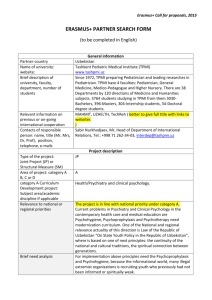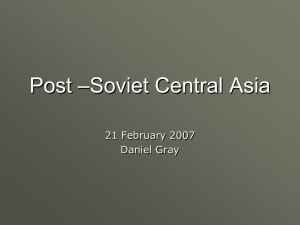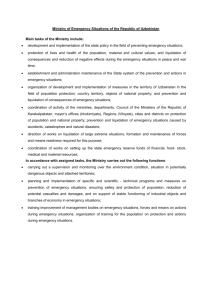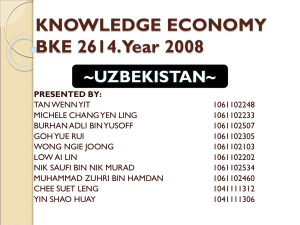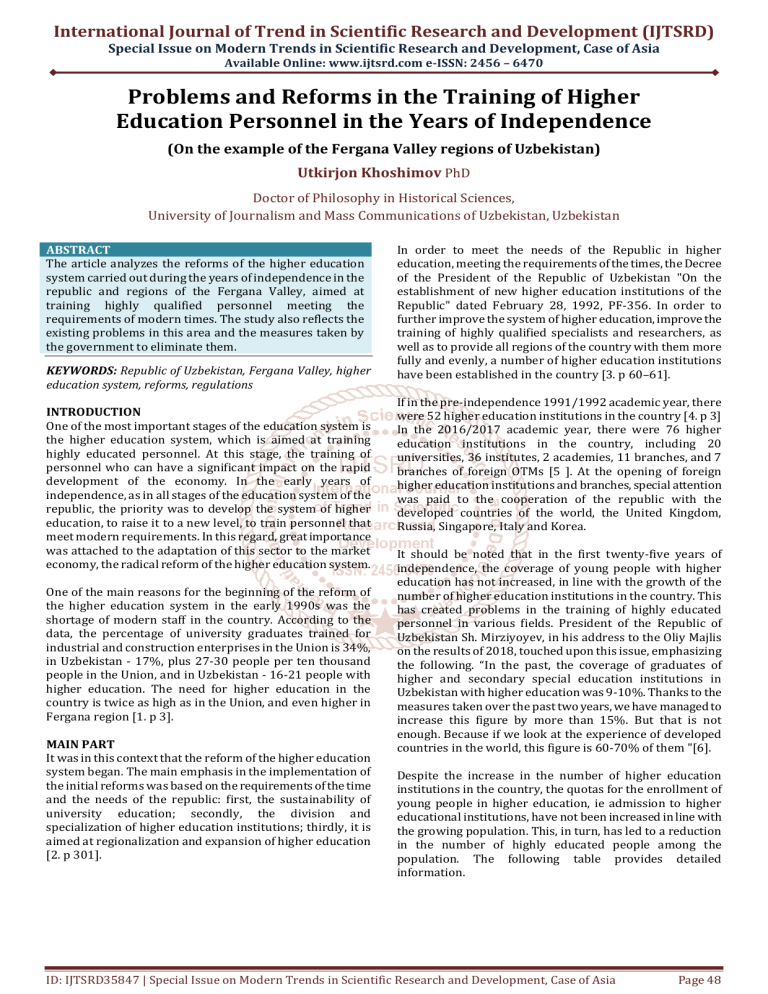
International Journal of Trend in Scientific Research and Development (IJTSRD)
Special Issue on Modern Trends in Scientific Research and Development, Case of Asia
Available Online: www.ijtsrd.com e-ISSN: 2456 – 6470
Problems and Reforms in the Training of Higher
Education Personnel in the Years of Independence
(On the example of the Fergana Valley regions of Uzbekistan)
Utkirjon Khoshimov PhD
Doctor of Philosophy in Historical Sciences,
University of Journalism and Mass Communications of Uzbekistan, Uzbekistan
ABSTRACT
The article analyzes the reforms of the higher education
system carried out during the years of independence in the
republic and regions of the Fergana Valley, aimed at
training highly qualified personnel meeting the
requirements of modern times. The study also reflects the
existing problems in this area and the measures taken by
the government to eliminate them.
KEYWORDS: Republic of Uzbekistan, Fergana Valley, higher
education system, reforms, regulations
INTRODUCTION
One of the most important stages of the education system is
the higher education system, which is aimed at training
highly educated personnel. At this stage, the training of
personnel who can have a significant impact on the rapid
development of the economy. In the early years of
independence, as in all stages of the education system of the
republic, the priority was to develop the system of higher
education, to raise it to a new level, to train personnel that
meet modern requirements. In this regard, great importance
was attached to the adaptation of this sector to the market
economy, the radical reform of the higher education system.
One of the main reasons for the beginning of the reform of
the higher education system in the early 1990s was the
shortage of modern staff in the country. According to the
data, the percentage of university graduates trained for
industrial and construction enterprises in the Union is 34%,
in Uzbekistan - 17%, plus 27-30 people per ten thousand
people in the Union, and in Uzbekistan - 16-21 people with
higher education. The need for higher education in the
country is twice as high as in the Union, and even higher in
Fergana region [1. p 3].
MAIN PART
It was in this context that the reform of the higher education
system began. The main emphasis in the implementation of
the initial reforms was based on the requirements of the time
and the needs of the republic: first, the sustainability of
university education; secondly, the division and
specialization of higher education institutions; thirdly, it is
aimed at regionalization and expansion of higher education
[2. p 301].
In order to meet the needs of the Republic in higher
education, meeting the requirements of the times, the Decree
of the President of the Republic of Uzbekistan "On the
establishment of new higher education institutions of the
Republic" dated February 28, 1992, PF-356. In order to
further improve the system of higher education, improve the
training of highly qualified specialists and researchers, as
well as to provide all regions of the country with them more
fully and evenly, a number of higher education institutions
have been established in the country [3. p 60–61].
If in the pre-independence 1991/1992 academic year, there
were 52 higher education institutions in the country [4. p 3]
In the 2016/2017 academic year, there were 76 higher
education institutions in the country, including 20
universities, 36 institutes, 2 academies, 11 branches, and 7
branches of foreign OTMs [5 ]. At the opening of foreign
higher education institutions and branches, special attention
was paid to the cooperation of the republic with the
developed countries of the world, the United Kingdom,
Russia, Singapore, Italy and Korea.
It should be noted that in the first twenty-five years of
independence, the coverage of young people with higher
education has not increased, in line with the growth of the
number of higher education institutions in the country. This
has created problems in the training of highly educated
personnel in various fields. President of the Republic of
Uzbekistan Sh. Mirziyoyev, in his address to the Oliy Majlis
on the results of 2018, touched upon this issue, emphasizing
the following. “In the past, the coverage of graduates of
higher and secondary special education institutions in
Uzbekistan with higher education was 9-10%. Thanks to the
measures taken over the past two years, we have managed to
increase this figure by more than 15%. But that is not
enough. Because if we look at the experience of developed
countries in the world, this figure is 60-70% of them "[6].
Despite the increase in the number of higher education
institutions in the country, the quotas for the enrollment of
young people in higher education, ie admission to higher
educational institutions, have not been increased in line with
the growing population. This, in turn, has led to a reduction
in the number of highly educated people among the
population. The following table provides detailed
information.
ID: IJTSRD35847 | Special Issue on Modern Trends in Scientific Research and Development, Case of Asia
Page 48
International Journal of Trend in Scientific Research and Development (IJTSRD) @ www.ijtsrd.com eISSN: 2456-6470
Table 1
From the above table we can see that in 1991, 26 specialists
with higher education were trained per 10,000 population in
the country, and by 2000 this figure was 13, which is 50%
less than in 1991. In 2016, this figure was 20. As we noted
above, in 1991 the Republic was lagging behind the All-Union
level in terms of training more highly educated personnel
per 10,000 population, while in 2016 the figure was even
lower than in 1991. The number of higher education in
Andijan region was 16 in 1991, 14 in 2016, 11 in Namangan
in 1991, 11 in 2016, 16 in 1991 and 13 in 2016 in Fergana
region. In the Fergana Valley, we can see that the number of
highly educated personnel per 10,000 population is much
lower than the number of staff. If we take into account the
fact that the population increased by more than 30%
compared to 1991, this, of course, is a matter of concern.
The decrease in the number of people with higher education
among the population has led to a shortage of people with
higher education in a number of areas of society. For
example, out of about 60,000 educators working in the field
of preschool education, only 21% had higher education and
79% had secondary special education [7]. It was time to find
a solution to this and many other problems in the education
system, to develop this area at the level of modern
requirements.
It should be noted that in 2017, as in all areas of our society,
a lot of attention is paid to the implementation of a number
of reforms in the higher education system. Many important
decrees and resolutions of the President of the Republic on
the development and reform of higher education have been
adopted. Particular attention is paid to the effective
implementation of decrees and decisions. For example, if we
look at the quotas for admission of young people to higher
education institutions, in the 2018 academic year, the
enrollment of students in higher education institutions
increased by 30% compared to 2017 and by 62.4%
compared to 2016 [8. p 1]. At the same time, the number of
students studying in higher educational institutions of the
republic has increased. For example, in the 2016/2017
academic year it was 264095, in the 2017/2018 academic
year it was 279674, and in the 2018/2019 academic year it
was 344790 [9]. It is no exaggeration to say that the adoption
of the Decree of the President of the Republic of Uzbekistan
dated October 8, 2019 "On approval of the Concept for the
development of the higher education system of the Republic
of Uzbekistan until 2030" marked the beginning of a new
reform of higher education in the country. According to the
decree, by 2030, the level of higher education coverage will
be increased by 50% on the basis of the development of
public-private partnership in the field of higher education,
the organization of public and private higher education
institutions in the regions.
Great attention is paid to the consistent implementation of
reforms in the higher education system in the regions of the
Fergana Valley. For example, in Fergana region in 2018, the
Resolution of the President of the Republic of Uzbekistan
dated September 26, 2018 No PP-3952 "On the establishment
of a branch of the Latvian Higher School of Information
Systems Management in Fergana" and the Cabinet of
Ministers of the Republic of Uzbekistan dated September 22,
2018 VMQ-754 In accordance with the Resolution "On the
establishment of the Kokand branch of the Tashkent State
Technical University named after Karimov", branches of
leading higher educational institutions of the republic and
foreign countries were opened in Fergana region. At the
same time, it is no exaggeration to say that the establishment
of the first non-governmental Kokand University in the
country in 2019 is the result of the attention paid today to
the development of the non-governmental education system
in the country.
The effectiveness of the work aimed at developing the
system of continuing education in the Fergana region, as well
as in the country, is highly valued by international
organizations. In particular, the inclusion of Fergana, the
only city in Uzbekistan in the UNESCO World Network of
Educational Cities, is one of the most educated cities in the
world. Two years ago, there were 5 universities in Fergana
ID: IJTSRD35847 | Special Issue on Modern Trends in Scientific Research and Development, Case of Asia
Page 49
International Journal of Trend in Scientific Research and Development (IJTSRD) @ www.ijtsrd.com eISSN: 2456-6470
By increasing the attractiveness of the country's
universities, it is necessary to create ample
opportunities for foreign youth, including young people
from Central Asia, to study in the country's universities.
It is necessary to widely introduce information
technology in the system of higher education in the
exchange of documents, as well as to create an
environment of free movement and communication for
professors and students to work more on themselves.
region, today there are 11. These factors also played an
important role in making Fergana the most educated city in
the world.
In recent years, the state has paid great attention to the
development of higher education, training in modern
advanced areas and specialties, the opening of new higher
education institutions. In particular, in 2019, 19 new
universities, including 9 branches of prestigious foreign
universities, were opened to promote higher education. In
cooperation with leading foreign universities, training on
141 joint curricula has been launched. A total of 146,500
students were admitted to higher education institutions,
which is twice as many as in 2016 [11].
As a result of reforms in the sector, over the past three years,
new educational institutions and new ELPs have been
opened in the country in cooperation with advanced foreign
countries. In particular, in 2018-2020, 43 OTMs were
established, including 28 local and 15 foreign OTM branches.
To date, the number of OTMs in Uzbekistan has reached 125
[12]. As a result of the opening of branches of foreign ETCs in
the country and the attention paid to the development of the
non-governmental education system, today there are 22
branches of foreign ETCs and 9 non-governmental ETCs in
the country. The positive changes that are taking place as a
result of the reforms in this area will help young people to
acquire knowledge at the level of modern requirements and
become competitive professionals.
CONCLUSION
In conclusion, it should be noted that during the years of
independence, a number of achievements have been made in
the field of higher education in the country. But it should be
noted that along with the successes, there were also some of
the problems we mentioned above. In recent years, our
government has been paying great attention to the
development of higher education at the level of modern
requirements, increasing the quality and quantity of training
and providing them with all sectors of our economy.
Based on these, we want to put forward some suggestions;
It is necessary to set quotas for admission to universities
by universities, as well as to allocate targeted quotas in
areas with high demand for personnel in some areas of
socio-economic spheres.
It is necessary to further simplify the entrance exams to
universities and strengthen knowledge control over the
results of courses.
It is expedient to develop joint faculties in each
department of higher education.
Innovative technologies should be widely introduced
into the system of higher education.
BIBLIOGRAPHY
[1] Butaboev M., Yuldoshev B., Juraev Zh. Problems of the
past or market considerations // Life and economy.
1991 №9. – P. 3
[2]
Responsible editor Alimova DA History and
historiography of the development of education in
Uzbekistan. Essays II. Our "Sparks of Literature"
Tashkent, 2017. – P.301
[3]
Bulletin of the Supreme Council of the Republic of
Uzbekistan. 1992, No. 4, pp. 60–61.
[4]
Resolution of the State Statistics Committee of the
Republic of Uzbekistan 30.08. Reference number №01
/ 4-01-19-991 for 2018.
[5]
http://www.edu.uz/uz/otm/index# (March 29, 2017)
[6]
People's Word newspaper. Dec. 29, 2018, – P. 271–
272
[7]
http://www.uza.uz/oz/politics/prezidentmaktabgacha-talim-tizimini-islo-ilishga-ba-ishlang14-02-2018?sphrase_id=3473987 (20.02.2018)
[8]
Current archive of the Ministry of Higher and
Secondary Special Education of the Republic of
Uzbekistan. 12.12.2018 y. Letter No. 89-02-3735 Page
1.
[9]
Current archive of the Ministry of Higher and
Secondary Special Education of the Republic of
Uzbekistan. (Reforms in the higher education system.
Electronic resource.)
[10]
http://uza.uz/oz/society/far-ona-yuneskoning-aolisi-eng-imishli-sha-arlar-r-ykhatiga-23-09-2020
(25.09.2020)
[11]
Address of the President of the Republic of Uzbekistan
Sh.Mirziyoev
to
the
Oliy
Majlis
(http://uza.uz/oz/politics/zbekiston-respublikasiprezidenti-shavkat-mirziyeevning-oliy-25-01-2020)
[12]
Official telegram channel of the Ministry of Higher and
Secondary Special Education of the Republic of
Uzbekistan. (Edu.uz. 24.09.2020).
ID: IJTSRD35847 | Special Issue on Modern Trends in Scientific Research and Development, Case of Asia
Page 50

